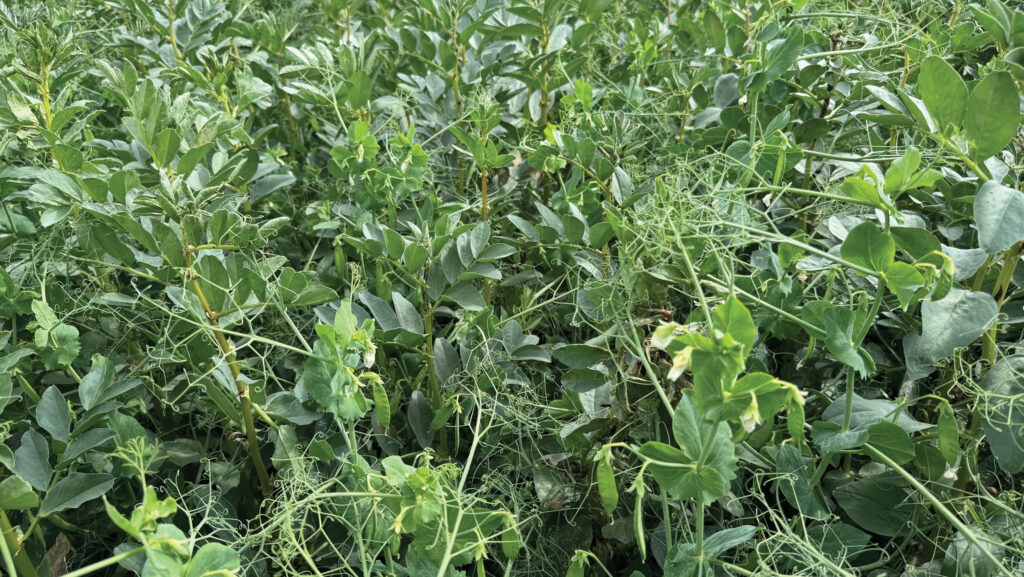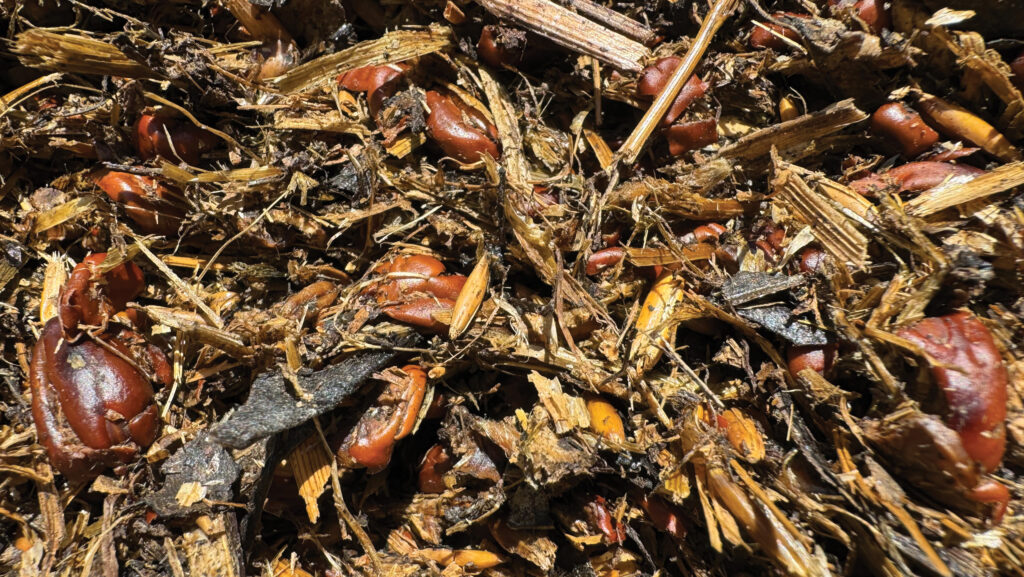Forage analysis: Which test is best for mixed crops?
 Bi-crop of peas and beans © Ann Hardy
Bi-crop of peas and beans © Ann Hardy Producers who rely on near-infrared spectroscopy to analyse forages such as mixed herbal leys, bi-crops and wholecrop legumes could be overfeeding or underfeeding key nutrients in their rations.
Inaccuracies of several percentage points in the analysis of protein, energy and fibre will have profound implications for the accuracy of diet formulations, according to silage consultant Dr Dave Davies of Silage Solutions.
The effects of this will be seen in livestock health and performance, profitability, and, potentially, environmental pollution.
See also: Red clover allows sustainable intensification on beef farm
The numbers
- 4 percentage points for protein
- 17 percentage points for starch
- 9 percentage points for neutral detergent fibre
Average discrepancies recorded between near-infrared spectroscopy and chemical analysis in wholecrop beans
Near-infrared spectroscopy (NIRS) is the technology used by most nutritionists and feed companies to analyse silages, often free of charge, he says.
It has generally served the farmer well, and in many situations continues to do so. But how accurate is this technology for the “new forages on the block”?

Dave Davies © Ann Hardy
How NIRS works
NIRS works by comparing each forage being tested with a prediction model. These models were generally developed for ryegrass in the late 1990s.
They use light in the near-infrared spectrum and measure how it is reflected from a forage sample.
This is then compared with a chemical analysis of the same sample (sometimes called wet chemistry), which provides a tried-and-tested measure of the actual components in the forage.
From these comparisons – preferably using a minimum of 300 samples for each forage type – a model based on the relationship between NIRS and wet chemistry is developed.
Once these calibrations are complete, NIRS can be used as a relatively quick, cheap and reliable predictor of the composition of the ryegrass silages historically grown in the UK.
But forages have changed markedly since NIRS was developed.

Bi-crop of peas and beans © Ann Hardy
Limitations
“If you have a mixed crop such as a herbal ley, NIRS is likely to be inaccurate.
That’s because you cannot take a prediction from one of its components and add it to another to create a new prediction model for the mixed crop,” says Dave.
Instead, he says that every herbal ley would need a model based on a reference set of herbal leys similar to that being tested.
“For NIRS to be accurate, it would require silages covering the whole range of variability found within that forage type to have been used in sufficient quantities to create the model,” he says.
“So, for multispecies crops, that means similar species in similar proportions at a similar stage of growth.
“Realistically, the laboratories don’t have these models and – in view of the number of variables they would have to account for – it is unlikely to stack up economically for them to be developed.
“And while models are updated with new samples on an ad hoc basis, the development of new models for different forages and forage mixtures has not kept pace with modern farming practices.”

Wholecrop beans © Ann Hardy
Lack of data
New crops can also run into problems, with an absence of historical data for use in a reference model.
“We witnessed this when high-sugar grasses came into widespread use in the 1990s, and we found their composition was not being predicted well.
“Even today, many labs have not caught up, and high-sugar grasses can be poorly predicted [for nutrient content] by NIRS,” Dave points out.
He says a similar situation now exists for wholecrop beans.
A recent comparative analysis carried out by Silage Solutions showed, on average, that NIRS overpredicted crude protein by four percentage units (NIRS 22.5%, wet chemistry at 18.5%); underpredicted starch by 17.1 percentage units (NIRS 6.4%, wet chemistry 23.5%); and overpredicted neutral detergent fibre (NDF) by nine percentage units (NIRS 46.8%, wet chemistry 37.8%) on a dry matter basis.
“A similar situation may exist for modern hybrids, such as festuloliums [a combination of fescue and ryegrass species], where reference sets have not kept pace,” he adds.
Changes to farming practices can also affect accuracy. Dave says even moving cutting dates can affect the suitability of NIRS as a test.
“Early-cut maize will not analyse well, as it is so different – both in terms of time of harvest and proportion of cob – from the maize forages that would have been used to create the reference data.”
He also warns against testing a total mixed ration using NIRS, as its multiple components from a variety of sources will make the prediction model unreliable.
Impact on health and performance
The effect of inaccuracies in forage analysis could weigh heavily on performance.
“Too much rumen-available protein – especially in relation to the amount of rumen-available energy – is wasteful, as excess nitrogen will be excreted by the cow in urine, potentially contaminating watercourses and increasing ammonia emissions,” he says.
An imbalance of protein and energy is also damaging for herd health, as it can cause infertility, lameness and many other metabolic diseases, he adds.
Alternative testing methods
With so much scope for inaccuracy, Dave suggests farmers look beyond NIRS when analysing forages.
Whatever the testing method, he advises sending a sample that is representative of the silage being fed the following day.
“Then, make sure you tell the labs what they are testing, as they need to know the composition of your forage to understand whether NIRS is appropriate for its analysis,” he says.
For straightforward ryegrass silages, he says NIRS can be sufficient and there may be no reason to question the results. However, if the NIRS raises any doubts, he advises an immediate query with the lab.
“Using the same forage sample within under a week, I would recommend wet chemistry. If the analysis is close to the NIRS, that should give confidence in the results.”
For alternative forages, he suggests accepting the free NIRS, but also undertaking wet chemistry from the outset for at least two components.
“Test for crude protein and NDF, and, if it is a starch-containing crop such as wholecrop cereals or pulses, analyse for starch as well.
“If the results come back fairly close to one another, you can have a degree of confidence in the NIRS.”
A chemical analysis will cost about £30 for protein and £50 for either NDF or starch.
“This cost is insignificant compared with the losses in milk yield or daily liveweight gain from an underspecified ration or the potential health issues of an unbalanced or inadequate diet,” he says.
Examples of modern forages and what they offer |
|
|
Forage type |
Possible reasons for growing |
|
Mixed herbal ley |
Tolerant of drought and flooding, improves soil structure, can reduce fertiliser use, can increase protein, increase biodiversity, environmental schemes |
|
Lucerne |
High protein, drought tolerant, multicut silage |
|
Legumes for wholecrop |
Sustainable home-grown protein, can reduce carbon footprint, break crop in arable rotation, no nitrogen and low phosphate and potash requirement. Check RB209 requirements for each crop |
|
Bi-cropping and undersowing |
Higher yield than single crops, complementary growth habit, can avoid bare soil, provide nitrogen for companion crop, establish a follow-on crop |
|
Festulolium |
Improved stress tolerance especially for drought and flooding |
